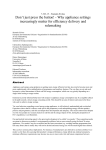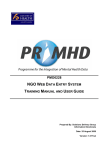Download here
Transcript
12 September 2011 Comments from ECOS on behalf of Environmental NGOs On the Working document for a possible Ecodesign regulation on Networked Standby Contact: ECOS – European Environmental Citizens’ Organisation for Standardisation Edouard Toulouse [email protected] / Tel: + 32 2 894 46 57 We welcome and support the Working document, especially the proposal to amend Regulation 1275/2008 and favour a horizontal approach. We strongly support that networked products should comply with the current standby requirements when their network ports are not used. Scope We suggest mentioning indirectly-powered products in the revision clause so that they can be included in the scope of the regulation next time. This includes powered over USB, powered over Ethernet and powered over phone landline products. A measurement protocol will have to be set, and we strongly encourage the European Commission to mandate standardisation bodies in this respect. Ambition and timing of the requirements We consider that the 1st and 2nd tiers should start after one and three years respectively. If the amendment is published in mid-2012, tier 1 should start in mid-2013 and tier 2 in mid-2015. We do not see a reason why the requirements should be less ambitious than in the preparatory study. (These levels had already been accommodated to be applicable to all network products). This suggests changing the level in Tier 1 for low network availability from 4 to 3 W. We also strongly request the addition of a 3rd tier after 5 years requiring products in the low network availability standby mode to consume less than 1 W. Signal must be sent to the industry that in the long term networked standby modes should converge with simple standby. Power management In Chapter 2 relating to power management, the mention ‘unless inappropriate for the intended use’ is as usual a major threat of big loopholes and controversies in market surveillance. We suggest being more specific on this point, by changing the mention into: ‘…unless justified by the use of internationally recognised network communication standards that are not supporting network standby and were published prior to 31/12/2016.’ 1 This would reduce the risk of loopholes and make sure service providers develop sustainable communication protocols. In the power management provisions, it is unclear whether the maximum time of 1 hour to switch to network standby is applicable only to Low Network or also to High Network equipment. We suggest clarifying this by mentioning that the provision applies to both. It should be mentioned somewhere (in the definitions or future guidelines) that ‘network connectivity’ cannot be considered as a main function of the product in the interpretation of Chapter 2 - 1.(a) More savings through user-friendliness The Working document misses some important user aspects that can yield substantial additional energy savings. We suggest the following additional requirements in Chapter 2: Chapter 2 Ecodesign Requirements – Power Management In addition to the requirements set out in Annex II(1) and (2) of Regulation (EC) 1275/2008 the following requirements shall apply: 1. Power management for networked products (…) (f) Products with low network availability and for which network access is not the main functionality shall be delivered with the wireless connections deactivated. Rationale: ensures that wireless emissions and networked standby are only activated if the user wishes so. (g) If the network availability specified by the manufacturer is high, the product shall offer a setup menu allowing the user to set its preferred latency before powering down and define time periods over a week in which the product switches automatically to a condition without network availability not exceeding 1,0 Watt. This menu shall pop up at first operation/installation of the product for user configuration. Rationale: some consumers would like to have a way to automatically deactivate their networking products (home gateways, internet boxes…) at certain times (e.g. during the night or during working hours when nobody is at home). The only option today is to unplug / plug the product manually each time. A programmable set-up would be the solution. As an illustration, an internet gateway going to a very low-power mode (instead of high network availability standby) during the night and working hours from Monday to Friday would save 55 kWh over a year. Applied to all EU internet gateways, this represents 8 TWh / year of additional savings. (h) If a networked product offers a manual switch, this switch shall send the product into a condition not exceeding the applicable power consumption requirements as defined in Chapter 3 (a) and (b). Rationale: we have heard complaints about internet equipment with a misleading on/off switch. Pressing this button only switches off the panel lights, but has no effect on the on-mode. There should be a safeguard requirement to prevent such situations. (i) Networked products that do not offer a power management function as described in 1.(a) because it is deemed inappropriate for the intended use shall offer a manual switch by which the user may force the product to go into a condition which does not exceed the applicable power consumption requirements for off mode and/or standby mode as defined in Annex II (1) and (2). The user manual shall inform that in this condition the product does not perform its network functionalities anymore. 2 Rationale: products for which the manufacturer is not able to implement an auto-power down sequence to a lower network standby mode should offer the possibility to be manually switched off. It would not be acceptable that such products can remain always-on without any possibility of user control. (j) Users shall be informed that a product is in a networked standby mode by an indication on the product that is unambiguously differentiated from off and standby mode. Rationale: users could be misled about the state the product is entering into when powering down. To avoid confusion, the network standby modes should be differentiable from passive standby. Reference to IEEE 1621 or IEC 60417 standardised symbols could be possible here. END. 3








